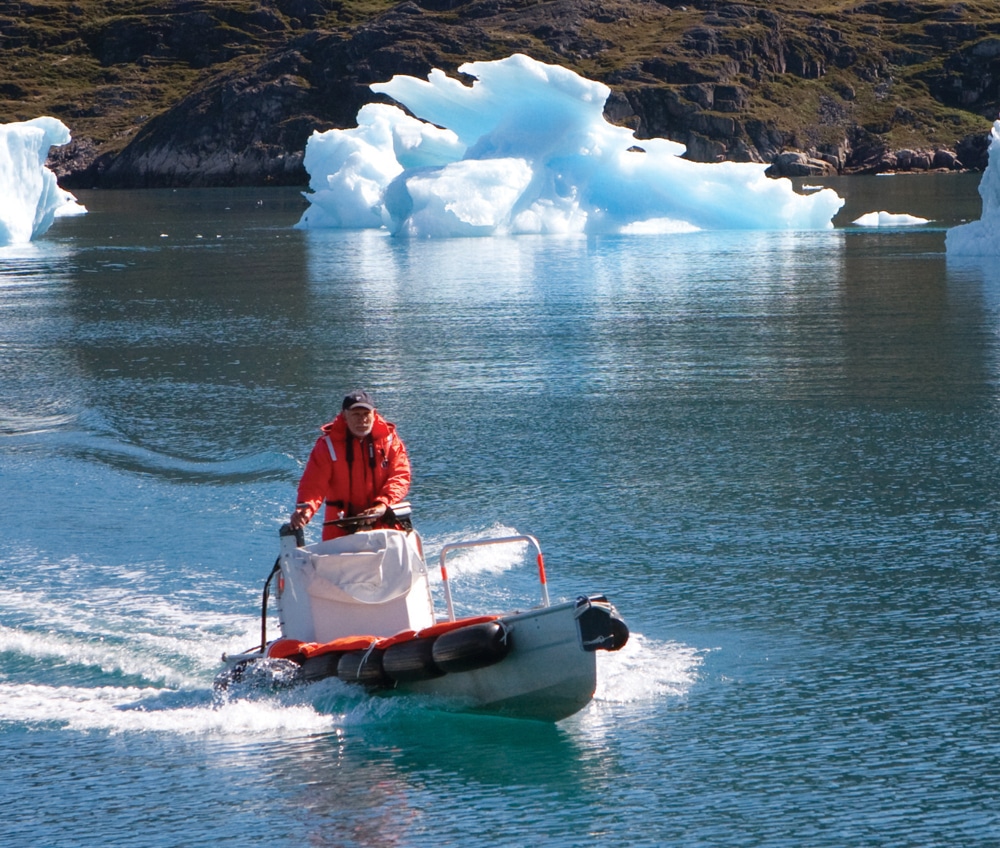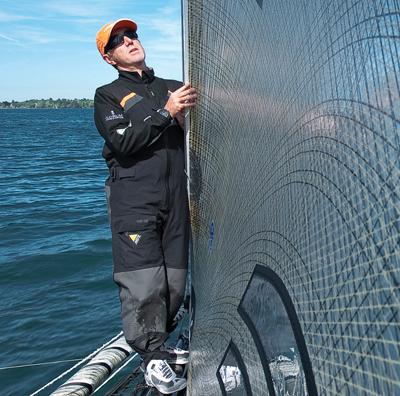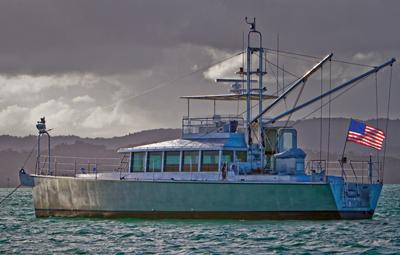
In the Face of Adversity
It’s time to get out of your comfort zone. Trying to do more with your boat means that you may run across situations that you haven’t seen before. Perhaps you won’t be running dive expeditions in the Galápagos. Maybe you won’t transit the South Pacific, or attempt to sail around the world alone. But if you push your own envelope properly, like the experts we spoke to here, and learn from the challenges you face, your comfort zone will grow larger each time you cast off.
The Power of Preparation
Tom Zydler is captain of Whale Song, a 94-foot Trinity/Halter expedition yacht owned by Grant Wilson. Zydler and his crew had a problem arise in a tight channel with some commercial traffic.
“Whale Song entered the narrow channel leading between shallows on both sides, into the port of Benoa [in Indonesia],” said Zydler. “On the opposite end of the channel heading directly towards us, an outbound 400-foot Japanese ship was also entering the channel. We would be passing portside to portside within yards of one another. The bow thruster would help to keep a straight course at the edge of the channel and the extremely close quarters. The engineer was sent down to turn on the second generator, dedicated to running the bow thruster. A minute later all electrical power cut out. We lost the steering—an electronic system dependent on 125 V AC supply—and had no bow thruster. Only the engines controls and gear controls, operated off a compressed-air system, could be used to try to prevent a collision.” Zydler’s wife Nancy, the mate, took over the controls while Zydler bounded down to the engineroom and the power distribution board.
While Zydler was effecting a repair of the system, he was unaware that the combination of the current and shoaling water (Whale Song draws 8.5 feet) had swung the vessel to port, across the bow of the oncoming vessel, straight towards the shoal. “Nancy kept going to port, trying to stay in the deeper water of the channel and stay parallel to the Japanese ship,” says Zydler. “But, nearly out of control because of the shallow water, Whale Song crossed the bow of the ship again. When I got back on the bridge to reactivate the steering, Whale Song was heading out and the Japanese ship was passing within a fender diameter on our starboard side. The engineer who had been just recently brought on, was unaware of our distribution board’s whims.”
The Lesson: “Get your necessary systems turned on and tested well before entering confined waters,” says Zydler. “And train the person in charge of the engineroom to deal with all the idiosyncrasies of your vessel.”
Communication Breakdown
Dan Stabbert of Stabbert Maritime Yacht and Ship knows a bit about the importance of communicating (see “Just Add Water” June 2009). The company buys boats and refits them, specializing in research ships. In addition to running these vessels and managing them, Stabbert Maritime also has an oceangoing tugboat operation and has done refits on seven yachts. “We’ll use them ourselves a little bit and then we’ll charter them out around the world,” Stabbert says. “We’ve done some really cool stuff. We take our guests to some unique places.”
But farflung locales mean increased risk—there’s not always a U.S. Coast Guard station or safe harbor right around the next point. “Most problems come down to people problems,” says Stabbert. “We almost lost a whole complement of guests in the Galápagos and it was a very harrowing experience, but it was mostly a matter of communication and personalities and that’s generally where you lose safety.”
The situation seems to have begun in the excitement of a new adventure. “When you have owners and clients aboard, people don’t want to thwart their wishes,” says Stabbert. “They’ll have a good plan set up and then all of a sudden someone will want to deviate from that. Deviation is excitement—being able to do things differently, that’s why you own these expedition yachts.” Stabbert had done the refit and was managing the boat, which had just traveled thousands of miles to the Galápagos and had a very sophisticated diving package and a crew of 12 and a helicopter on board. They anchored off Wolf Island.
“Generally once you arrive everyone wants to get in the water,” says Stabbert. “A lot of things happen all at once. The helicopter’s starting to fly. You’ve got skiffs in the water, people want to go sailing, and then you’ve got people that want to go diving. We dropped anchor at 6:30 in the morning, and not 20 minutes later, we’ve got the diesel skiff in the water with seven divers and two crew and they want to go to the west side of the island, where the local divemaster said there was some great diving.”
The dive-launch crew called the yacht and said they were doing a brief dive, and that everything was going according to plan. “The divers decided once they were down there—the clients saw some beautiful fish and the current was starting to take them and they pointed and made gestures to follow the current and the beautiful fish,” says Stabbert. “So they changed their plan and didn’t notify anybody, a group of divers plus two very senior divemasters. They were swept by the current along the Southeast side of Wolf Island and they didn’t think much of it, they were mesmerized by everything.”
The dive launch had difficulty reaching the yacht due to weather conditions and an interceding point of land affecting the VHF. After beginning a search, the launch finally was able to communicate the situation to the yacht, and they joined in the search. They located the full complement and got them on board. The divers had been in the water for 3 1/2 hours.
The Lesson: “We determined that there was no contingency for loss of communications that were critical,” says Stabbert. “That’s the maritime business: Something can be odd—if it’s odd all the time you’re okay, but the minute it changes, you need to start paying attention to it.”
Problem-Solving Perspective
Loïck Peyron is an accomplished bluewater racing sailor, having crossed the Atlantic 43 times, 18 of them singlehanded, among other feats. Successful singlehanded sailors understand better than most the need to take a fresh view of problems. “The first time I [came to aid of a fellow racer in distress] was 20 years ago during the first Vendée Globe in 1990,” says Peyron. “[Another racer] Philippe Poupon, a good friend of mine, sent a distress message. At this time we did not have any satellite phone and were just working with radio. It was in the South Atlantic, quite far south, maybe three weeks after the start. Nobody knew what happened to him. I was the closest to his position, the last position. It took 24 hours against a big, rough sea and I hoped to find him when I arrived on the position, I didn’t know if he was in his life raft or maybe the boat sank. I discovered the situation, which was quite bizarre, because the boat was not upside-down, not sunk, but on one side—the mast exactly parallel to the water. When I arrived alongside the boat, I thought the keel was not there, but it was there. The reason was that the boat was a sloop [when it was launched], and just before the start of the race, they decided to add a mizzenmast and the weight of the mizzenmast made the balance of the boat change. Poupon spent 24 hours in this position and he was really sure to sink, and he was quite afraid when I arrived at the boat.”
“The interesting thing is he didn’t sort it out himself about cutting the mizzenmast, and so I had to say that to him,” says Peyron. “He cut the rig of the mizzenmast and then the boat came back, and that was a very nice moment. But for me that was not a nice moment, because that was my first round-the-world trip. And we were not at the end, but just at the beginning. Maybe he saved me because I was the only one between all the opponents of the race to have seen this show, and maybe it calmed me a little. I entered the Indian Ocean with a bit more conservative view.”

The Lesson: “When you have a big problem, sometimes you are only focusing on one thing,” says Peyron. “It’s very important to have the wider view of the problem like when two chess players are thinking about their game and you just arrive and you immediately see something that they don’t because you have another view. It’s very interesting to try to see a situation from the outside.”
Deck Duty
Steve Dashew has sailed the world and now pushes the envelope, too, in his 80-foot fast pilot boat, Wind Horse. He made a passage from Tonga to Fiji on Intermezzo, a 50-foot Bill Tripp yawl, in 1977—before GPS. “Navigation is tricky,” Dashew says. “There are lots of reefs and currents and we left with a full moon for good visibility. Of course, it got overcast so we didn’t get a single round of celestial observation. So, we’re all on dead reckoning and we’re about halfway through the passage, about 450 miles if I recall, and the moon was trying to poke through. I had a sextant sitting next to me in the cockpit, just in case. I got what I thought was the bottom of the moon, but there was a big sea running, blowing about 30 or 35 knots, waves, and we were running wing-and-wing. And you’re never really sure in those conditions, and it’s hard to see the horizon. The sight that I got worked out put us about 60 or 70 miles north of where we thought we were. But you can easily be off [by] that much.” Unable to confirm the location, Dashew took the information at face value.

“About 15 or 20 minutes later we came up on a wave and I saw a white line ahead of me—It’s breakers. No it can’t be,” Dashew says. “We came up again on the next wave and saw that there were breakers ahead of us for sure.”
Dashew sprang into action. “We were wing-and-wing and so the main had a preventer to the bow in back of the cockpit and the spinnaker pole, which the jib was on, also had a preventer coming back to the cockpit,” Dashew says. “Instinctively, I cut both preventers and gybed the boat…and drove the boat into the wind and stopped her. We had a big jib on the pole and we had to get that put away and get the mess cleaned up, and so we set a heavy staysail, and double-reefed the main. We know we’re in some reef area, but we don’t know where—you know, if you sailed in an entrance you can’t move. So we just short-tacked for about three hours—tack, five minutes on the next tack, just holding position. The sun comes up and we looked behind us. We had sailed into something called a horseshoe reef.”
The Lesson: “If I hadn’t been on deck, we would have lost the boat, and might have lost our lives: There was a big sea running,” says Dashew. “So after that, whenever we were within 100 miles of anything that could bite the boat we had someone on deck all the time.”









